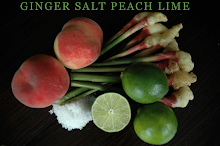It's a rare thing for me to follow a recipe. With the exception of my grandmother Ruth's cornbread recipe, I gave up following cooking instructions to the letter long ago. When tackling a roast, I want to know what both Julia and Jacques have to say. If I want to make chocolate chip cookies, I'll refer to four or five recipes, including the one on the back of that yellow package. In need of the correct proportions for vegetable stock or spicy squid salad or jambalaya? I can spend half a morning consulting my favorite websites and books -- from A to at least R, a collection that doesn't quite complete the alphabet but gives me reliable and delicious ideas. (Like many cooks, I'm in complete denial that I own anything having to do with S.)
I compare ingredients, ponder techniques, make notes. Then I take that advice and dump it into the mixing bowl. Sometimes, I overestimate my ability to edit carefully tested recipes. Mostly I like what comes out of my melting pot.
This habit must be put aside, however, with the introduction of Shizuo Tsuji into my kitchen. I'm treading on new ground with this attempt to learn more about Japanese food, and it's an understatement to say I don't know what I'm doing. Guess at the proportions of soy sauce to mirin? I might as well figure out how to read blogger's computer code. It's not that Tsuji's recipes and instructions are terribly difficult. There's a thorough glossary, helpful sketches, menus for beginners. Still, it took me a few days to select a place to start. On Sunday I finally settled on two dishes -- spinach with sesame dressing and mixed rice, gomoku meshi, a one-pot dish with five main ingredients.
I followed the instructions verbatim. It nearly killed me. I ground the sesame seeds. I scrubbed, rather than peeled, a dirty burdock root as long as my leg. I poured boiling water over fried tofu to wash out the excess oil. I wrung kitchen towels around spinach. I washed rice and let it drain for an hour. None of this was arduous or complicated, and other than planning for the rice-draining time, it didn't take that long. But mentally it was exhausting. I had conceded control, something I never do in the kitchen. Worse, I was getting hungry.
Then came the final instruction -- put all the mixed rice ingredients, including raw chicken and the konnyaku, into my American-made, $25, thin-as-tin rice cooker. In everything went. I was nervous, not just because I own a cheap rice cooker. I had decided to cheat and made one major adjustment to the recipe. I used the rice to broth proportions suggested by my machine, rather than by Tsuji-san. He called for 3 1/2 cups of uncooked short-grained rice to 4 cups broth; the proportions are right, but that seemed like too big a feast for a Sunday dinner for one. I cut the amounts by about one-third, pointed the contraption's one lever toward the word "cook," and escaped to a shower.
About 20 minutes later I ventured back into the kitchen and lifted the rice cooker's lid. I'll be damned if dinner wasn't waiting for me. The rice was perfectly steamed, infused with the richness of chicken and tang of soy. The carrots were soft, not mushy. The bits of meat were tender and juicy. Only one part turned out less than perfect. The burdock was a little too crunchy, and I consulted the recipe again. It was my fault, of course. I hadn't cut it thinly enough.
Next time I'll be more careful. Or maybe I'll parboil it. And perhaps add an extra slug of mirin. I wonder if broccoli stems would hold up? How about a finger of ginger? Like that second bowl of gomoku meshi, I really just can't help myself.
Here's the recipe as it appears on page 278 of "Japanese Cooking: A Simple Art." If you don't have a rice cooker, you can make it with a large pot with a tight lid. The recipe is for four people.
Ingredients:
2 ounces boned chicken meat (I used two boneless thighs)
1 small burdock root, well scrubbed with a stiff brush*
1/2 small carrot
1/2 cake think deep-fried tofu
1/3 cake konnyaku
3 1/3 cups short-grain rice, washed
4 cups dashi (japanese broth, or chicken broth)
4 tablespoons mirin
3 tablespoons light soy sauce
3 tablespoons dark soy sauce
Cut chicken into bite-sized pieces, with or without the skin, as preferred, but do not use bones.
Cut burdock using the pencil-shaving technique (very thin, slanted pieces, as it the vegetable is being whittled). Place in cold water immediately to prevent discoloration.
Finely dice carrot.
Remove excess oil from fried tofu cake by pouring on scalding water. Drain, wrap in a kitchen towel or strong paper toweling, and gently squeeze out excess oil. Cut both fried tofu and konnyaku into julienne stripes.
To assemble and cook: Use an earthenware casserole, a heavy-lidded pot, or an electric or gas rice cooker. Place washed rice and solid ingredients into casserole or pot.
In a bowl, mix the ingredients for cooking rice (dashi, salt, mirin, soy sauces). Check and correct seasoning. Pour over rice and vegetables in casserole. Do not stir. Cover casserole or pot. Cook, simmering carefully without lifting the lid, as the mixture can scorch easily.
*According to the recipe, you can use shredded shiitake mushrooms instead of burdock.
Subscribe to:
Post Comments (Atom)


No comments:
Post a Comment